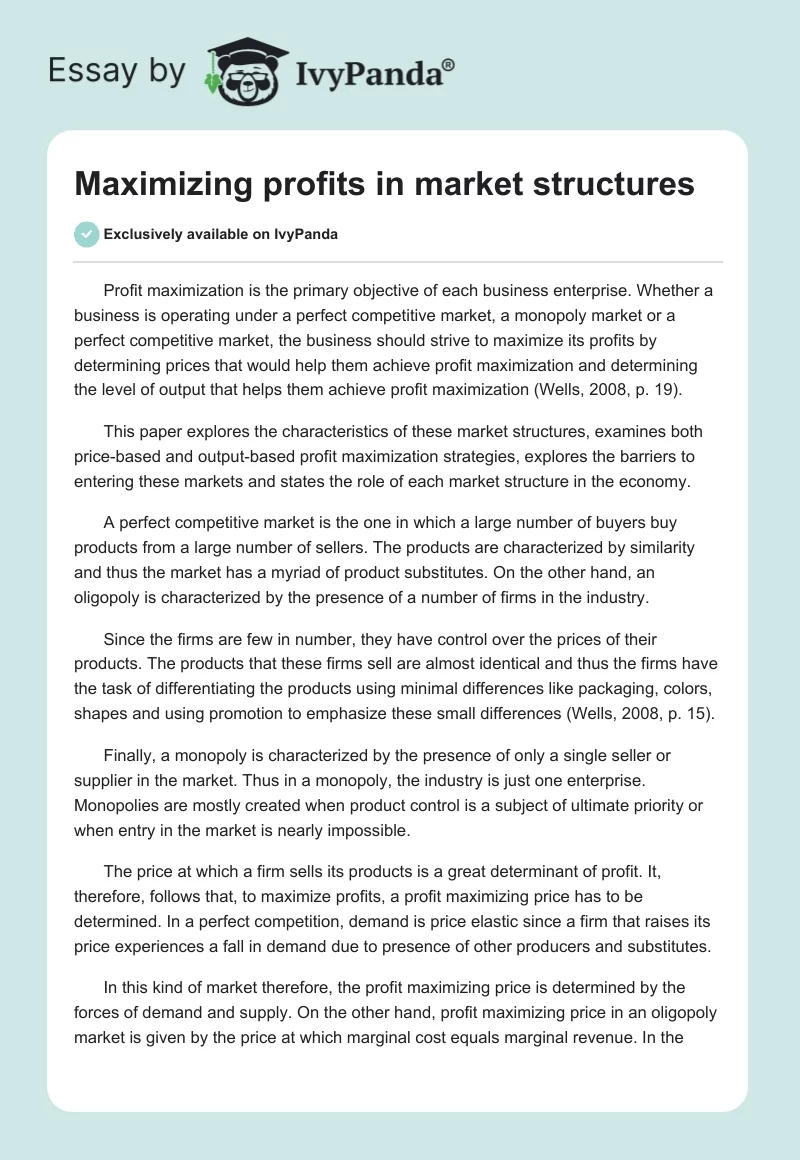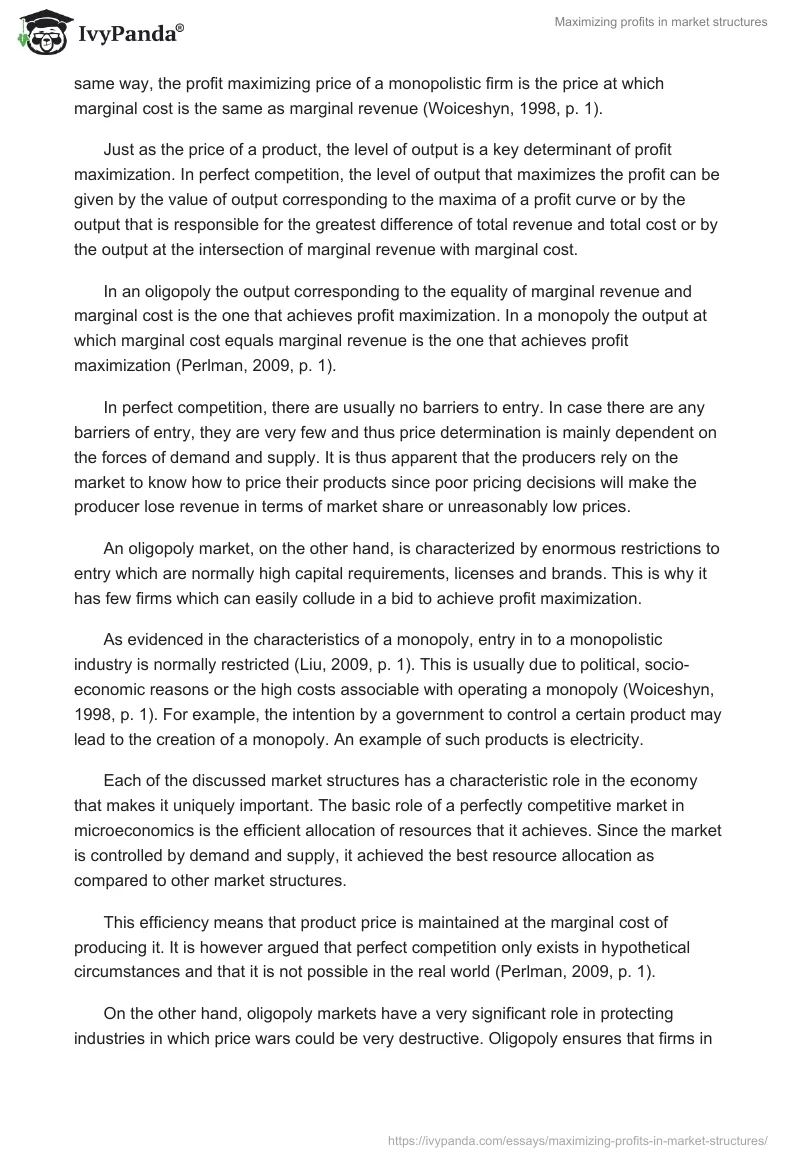Profit maximization is the primary objective of each business enterprise. Whether a business is operating under a perfect competitive market, a monopoly market or a perfect competitive market, the business should strive to maximize its profits by determining prices that would help them achieve profit maximization and determining the level of output that helps them achieve profit maximization (Wells, 2008, p. 19).
This paper explores the characteristics of these market structures, examines both price-based and output-based profit maximization strategies, explores the barriers to entering these markets and states the role of each market structure in the economy.
A perfect competitive market is the one in which a large number of buyers buy products from a large number of sellers. The products are characterized by similarity and thus the market has a myriad of product substitutes. On the other hand, an oligopoly is characterized by the presence of a number of firms in the industry.
Since the firms are few in number, they have control over the prices of their products. The products that these firms sell are almost identical and thus the firms have the task of differentiating the products using minimal differences like packaging, colors, shapes and using promotion to emphasize these small differences (Wells, 2008, p. 15).
Finally, a monopoly is characterized by the presence of only a single seller or supplier in the market. Thus in a monopoly, the industry is just one enterprise. Monopolies are mostly created when product control is a subject of ultimate priority or when entry in the market is nearly impossible.
The price at which a firm sells its products is a great determinant of profit. It, therefore, follows that, to maximize profits, a profit maximizing price has to be determined. In a perfect competition, demand is price elastic since a firm that raises its price experiences a fall in demand due to presence of other producers and substitutes.
In this kind of market therefore, the profit maximizing price is determined by the forces of demand and supply. On the other hand, profit maximizing price in an oligopoly market is given by the price at which marginal cost equals marginal revenue. In the same way, the profit maximizing price of a monopolistic firm is the price at which marginal cost is the same as marginal revenue (Woiceshyn, 1998, p. 1).
Just as the price of a product, the level of output is a key determinant of profit maximization. In perfect competition, the level of output that maximizes the profit can be given by the value of output corresponding to the maxima of a profit curve or by the output that is responsible for the greatest difference of total revenue and total cost or by the output at the intersection of marginal revenue with marginal cost.
In an oligopoly the output corresponding to the equality of marginal revenue and marginal cost is the one that achieves profit maximization. In a monopoly the output at which marginal cost equals marginal revenue is the one that achieves profit maximization (Perlman, 2009, p. 1).
In perfect competition, there are usually no barriers to entry. In case there are any barriers of entry, they are very few and thus price determination is mainly dependent on the forces of demand and supply. It is thus apparent that the producers rely on the market to know how to price their products since poor pricing decisions will make the producer lose revenue in terms of market share or unreasonably low prices.
An oligopoly market, on the other hand, is characterized by enormous restrictions to entry which are normally high capital requirements, licenses and brands. This is why it has few firms which can easily collude in a bid to achieve profit maximization.
As evidenced in the characteristics of a monopoly, entry in to a monopolistic industry is normally restricted (Liu, 2009, p. 1). This is usually due to political, socio-economic reasons or the high costs associable with operating a monopoly (Woiceshyn, 1998, p. 1). For example, the intention by a government to control a certain product may lead to the creation of a monopoly. An example of such products is electricity.
Each of the discussed market structures has a characteristic role in the economy that makes it uniquely important. The basic role of a perfectly competitive market in microeconomics is the efficient allocation of resources that it achieves. Since the market is controlled by demand and supply, it achieved the best resource allocation as compared to other market structures.
This efficiency means that product price is maintained at the marginal cost of producing it. It is however argued that perfect competition only exists in hypothetical circumstances and that it is not possible in the real world (Perlman, 2009, p. 1).
On the other hand, oligopoly markets have a very significant role in protecting industries in which price wars could be very destructive. Oligopoly ensures that firms in such industries are protected against unreasonable competition since their products are normally costly to produce.
The raw materials for these products are also difficult to access and therefore, the market structure ensures that the materials are well utilized by ensuring that reasonable prices are given to products and thus quality products are made. Oligopoly markets are also very instrumental in the protection of rights of production.
This ensures that firms are not adversely affected by counterfeiting. Finally, monopolies encourage what could be described as allocative inefficiency. This means that goods will be sold above marginal cost due to the power and control associated with monopoly markets.
This makes the consumers lose their surplus and thus it makes the economy lose its efficiency. Monopolies are instrumental in helping the protection of industries producing sensitive products (Liu, 2009, p. 1). This ensures that consumers do not run out of products that are compulsory in life. This is why monopoly markets are able to manipulate prices as they wish; the products they offer are a must have. This compromises consumer surplus in other goods.
The characteristics of the discussed market structures make each of them unique in its own way. While monopolies are a “one-mans show”, oligopolies are composed of a number of suppliers while a perfect competition has a large number of suppliers or retailers. These characteristics make price determination and determination of output in the different market structures a variable practice.
They also make them have variable effects on the economy as a whole. In virtually all market structures, profit maximization is achieved at the price or level of output at which the marginal cost is the same as marginal revenue. All the other market structures have barriers to entry except a perfect competition.
Reference List
Liu. W. (2009). Potential benefits from monopoly. Web.
Perlman, K. (2009). Price Determination. Web.
Wells, R. (2008). Microeconomics. New York. Barnes & Noble.
Woiceshyn. G. (1998). “Perfect” competition versus freedom of competition. Web.


